|
Nieuport 28C1
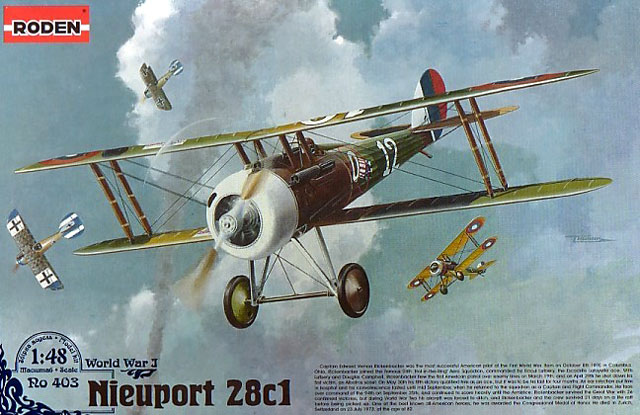
Roden,1/48 scale
S
u m m a r y
|
| Catalogue Number: |
Roden 1/48 scale Nieuport 28C1 Kit
#403 |
| Scale: |
1/48 |
| Contents and Media: |
Six sprues of light grey plastic and
two sheets of decal |
| Price: |
USD$17.97 from Squadron.com
|
| Review Type: |
FirstLook |
| Advantages: |
Excellent fit, nice stringer
detail, razor sharp wing trailing edges, good attention to detail. |
| Disadvantages: |
Decals slightly out of
register, Insignia too big |
| Recommendation: |
Highly Recommended |
Reviewed by Robert Baumgartner

Roden's 1/48
scale Nieuport 28C1 is available online from Squadron.com
When the United States entered WWI in 1917 she desperately needed some
fighter aircraft.
The French meanwhile had just put the new Spad 13 C.1 into production
and was not going to adopt the newly developed Nieuport 28 C.1, which they
saw as an inferior machine. This was an opportunity America couldn’t
refuse so they a purchased 297 of the aircraft.
The 95th Aero Squadron was the first to receive the new fighter and this
occurred in late February 1918. The 94th followed a few weeks later but as
there were no guns available at the time the first patrols were made with
the aircraft unarmed.
Various problems plagued the fighter, not least was its tendency to shed
the upper wing fabric when coming out of a high-speed dive. It was only
the fact that the ailerons were on the lower wing that some pilots were
able to bring their aircraft down safely.
Another problem was that engine vibration would crack the fuel lines.
This was due to improper annealing and the rigidity of the copper tube
that was used.
When these problems were ironed out, the Nieuport 28 was seen as a
pleasant aircraft to fly, testimony being the US Army’s order of an
additional 600 at the war’s end.
America’s first fighter finally gets some attention from a mainstream
kit manufacturer.
Roden have come to the party with the first of what will undoubtedly be a
series of releases in the markings of the different Aero Squadrons.
 The
box contains 51 plastic parts on two tan coloured sprues. An acetate sheet
is also included which takes care of the wrap around windscreen. A single
decal sheet allows five options to be built, in this case, all 94th Aero
Squadron examples. The
box contains 51 plastic parts on two tan coloured sprues. An acetate sheet
is also included which takes care of the wrap around windscreen. A single
decal sheet allows five options to be built, in this case, all 94th Aero
Squadron examples.
All parts were well moulded with crisp detail and no flash.
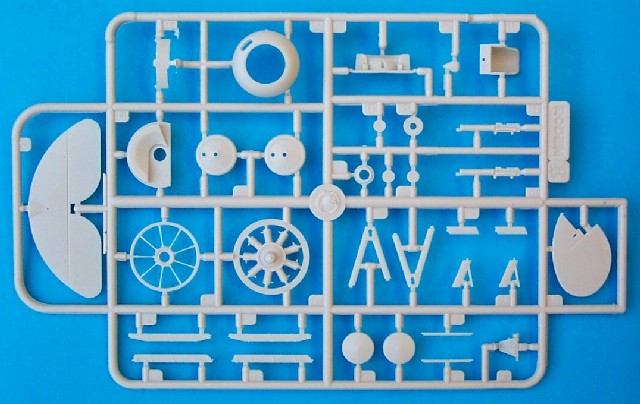
The first item on the agenda is to compare the contents with the Ian
Stair’s plans in Albatros Productions Datafile #36.
As expected the major parts matched up beautifully with only the
fuselage being a tad long. No problem here. What did surprise me was that
the rear outer struts in the kit were slightly shorter than the forward
ones. This was a deviation from the drawings.
For ease of manufacture the cowling is in two pieces. Roden’s attention to
detail can be seen by the inclusion of the oil filler cap and even the
25-litre oil tank itself. The engine detail on the 160hp Gnôme rotary is
very nice and the separate pushrods are as fine as one is likely to see in
injection-moulded plastic.
A great feature of this kit is that the fuselage halves can be assembled
before the inclusion of the cockpit detail. The later slides in from the
front as a sub assembly and on my example it was a perfect fit. Items
included are the interior wooden framework, rudder, control column, seat
and instrument panel. Note that this later item is modeled after a
restored example that had a detachable metal panel containing instruments
used for test flying. Modellers can easily cut this off the supplied part.
All this detail is more than adequate, as the small cockpit opening
doesn’t allow much to be seen anyway.
Both upper and lower wings come as one-piece affairs. This is a sensible
idea because the builder is then not presented with any strength or
dihedral problems.
Need a new kitchen knife? Hey, use the trailing edge of the wings!
These are the sharpest you will see in plastic and Roden have managed it
without any warping of the surfaces.
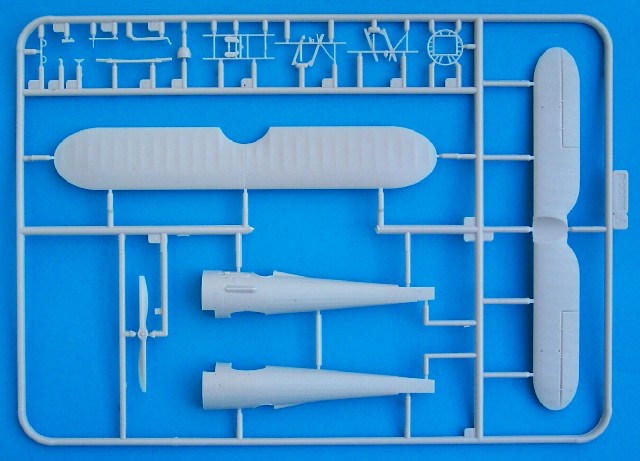
The tail plane and fin/rudder are equally as well done. I sanded a bit
more off the top of the fuselage cutout where this item sits so that the
leading metal capping is more in line with the stringers. This
necessitated a little sanding on the bottom of the rudder so that it still
finished level with the undersurface of the fuselage.
I deepened the cabane recesses on the fuselage so that I could play with
the length of these struts to help in the alignment of the top wing. This
worked wonderfully and the final assembly was a breeze. After the cabane
struts were glued and left to dry for a couple of hours, the upper wing
was added. When this was secure, the outer struts were simply slotted into
place.
Finally a manufacturer has done the undercarriage as one would expect it
to be while sitting on the ground. The split axle has actually been
moulded to show the weight of the aircraft, so don’t forget to splay the
wheels to match this. Full marks to Roden here!
The acetate windscreen worked well and really looks the part. It can be a
bit difficult to cut out so take care here.
A simplified rigging diagram is provided and purists will no doubt add the
twin flying wires that the instructions omit. It would also have been
handy if the diagram showed the top of the undercarriage bracing wires for
those that are not familiar with this setup.
A generous five options are provided for the modeler, all belonging to
the 94th Aero Squadron.
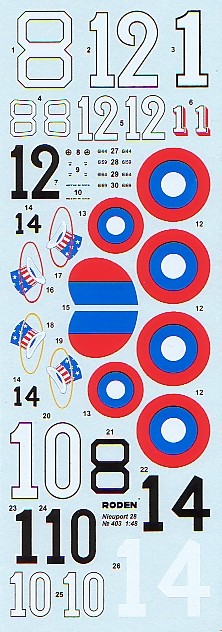 a)
Nieuport 28C1 s/n 6144 flown by Lt. James A. Meissner of 94th Aero
Squadron, France May 1918. a)
Nieuport 28C1 s/n 6144 flown by Lt. James A. Meissner of 94th Aero
Squadron, France May 1918.
On the 30th May 1918, Meissner stripped the fabric off his top wing in
this aircraft after colliding with an Albatros D.V of Jasta 65. This was
the second time he had lost wing fabric and on this occasion N6144 was
marked “white 8” as illustrated. This adventure got him an Oak Leaf
Cluster for his DSC. He scored two more victories with the 94th before
moving on to command the 147th Pursuit Squadron. There he scored another 4
victories to finish the war with a total of 8.
For those wondering about the yellow ring on the insignia of this
aircraft, it is believed that Meissner did have this painted in a
different colour than the usual red. For more information on this, check
out:
http://www.nasm.si.edu/museum/garber/nieuport/nieuport_fus.htm
b) Nieuport 28C1 s/n 6144 flown by Lt. James A. Meissner of 94th Aero
Squadron, France April 1918.
These are the markings that N6144 found itself in when Meissner
initially saw combat and lost his wing fabric for the first time. It
happened after he shot down a Hannover CL. IIIa of FA (A) 298b. Meissner
was able to land his aircraft safely and was awarded the DSC for his
actions.
Roden supply the numeral as “black 14” but modelers should note that red
is also a strong possibility. Builders should also be aware that the
zigzag marking on the cowl at this time was a reversal of what appeared
when the aircraft was marked as “white 8”.
c) Nieuport 28C1 s/n 6169 flown by Major John Huffer of 94th Aero
Squadron, France April 1918.
Huffer flew with various French Units (N95, N62, F36, Spa62) before
going on to command the 94th and 93rd Aero Squadrons. He died in 1986 at
the age of 91.
Edward Rickenbacker flew Huffer’s aircraft to score his third victory on
the 17th May. It was during this action that he had the fabric stripped
off the top wing when pulling out of a dive after downing an Albatros D.V.
d) Nieuport 28C1 s/n 6164 flown by Lt. Douglas Campbell of 94th Aero
Squadron, France March 1918.
Campbell was to score the 94th Aero’s first victory when he downed a
Pfalz D.III of Jasta 64w on the 14th April 1918. Those wishing to model
Campbell’s aircraft at this time should note that the white 10 and black
triangles on the cowl were not present at this time. Campbell survived the
war with 6 victories.
In 1939 he became the Vice President of Pan American Airways and later its
General Manager in 1948. At the age of 94 he passed away in December 1990.
e) Nieuport 28C1 s/n 6159 flown by Lt. Edward Rickenbacker of 94th Aero
Squadron, France April-May 1918.
Rickenbacker used N6159 to score his first victory on 29th April 1918.
On this occasion it was a Pfalz D.III of Jasta 64w. Another Pfalz was
scored in it on the 7th May. The aircraft as depicted came after these
incidents when Rickenbacker was to lead the 1st Flight. This is when the
cowling was painted white and the Third Liberty Loan posters were added to
the upper surfaces of the wings.
It should be noted that building any Nieuport 28 representing a period
early in the life of the 94th Aero Squadron, most likely had only a single
Vickers gun fitted due to the shortage of these items at the time.
The blue on my example was slightly out of register with the rest of
the printed colours. This resulted in the red being overlapped on the
roundels thus producing a third colour. It also meant that the “hat in the
ring” insignia was compromised.
Speaking of the insignia, a look through Charles Woolley’s excellent book
“The Hat in the Ring Gang” reveals that the representation of this on each
aircraft was slightly different. Not only do the stars and stripes vary in
number and position, but also their orientation on the fuselage. The
fastidious will notice that the supplied insignia is of a generic nature.
The real problem though is that it is too large for the fuselage but I
believe this is being fixed in later releases.
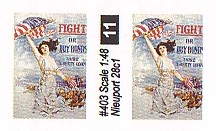 Roden
has supplied the Third Liberty Loan posters that were seen on many of
these aircraft as laser printed “stickers”. The idea behind this is that
it would have been too hard to produce the fine detail in decal form. The
original posters were “glued” onto the wing so theoretically they should
sit a little proud of the wing anyway. Roden’s solution works remarkably
well and under the final clear coat does not look out of place at all. Roden
has supplied the Third Liberty Loan posters that were seen on many of
these aircraft as laser printed “stickers”. The idea behind this is that
it would have been too hard to produce the fine detail in decal form. The
original posters were “glued” onto the wing so theoretically they should
sit a little proud of the wing anyway. Roden’s solution works remarkably
well and under the final clear coat does not look out of place at all.
This is an ideal kit for those building a WWI aircraft for the first
time. The assembly is uncomplicated and the fit is Roden’s best yet. In
fact more time is spent on painting the French 5 colour camouflage scheme.
All that remains is a bit better quality control by those that produce the
decals.
Highly Recommended
Thanks to
Squadron.com for the review
sample.
Review and Images Copyright © 2004 by
Robert Baumgartner
Page Created 09 March, 2004
Last updated 19 March, 2004
Back to HyperScale Main Page
Back to Reviews Page
|
Home | What's
New | Features
| Gallery |
Reviews | Reference
| Forum
| Search